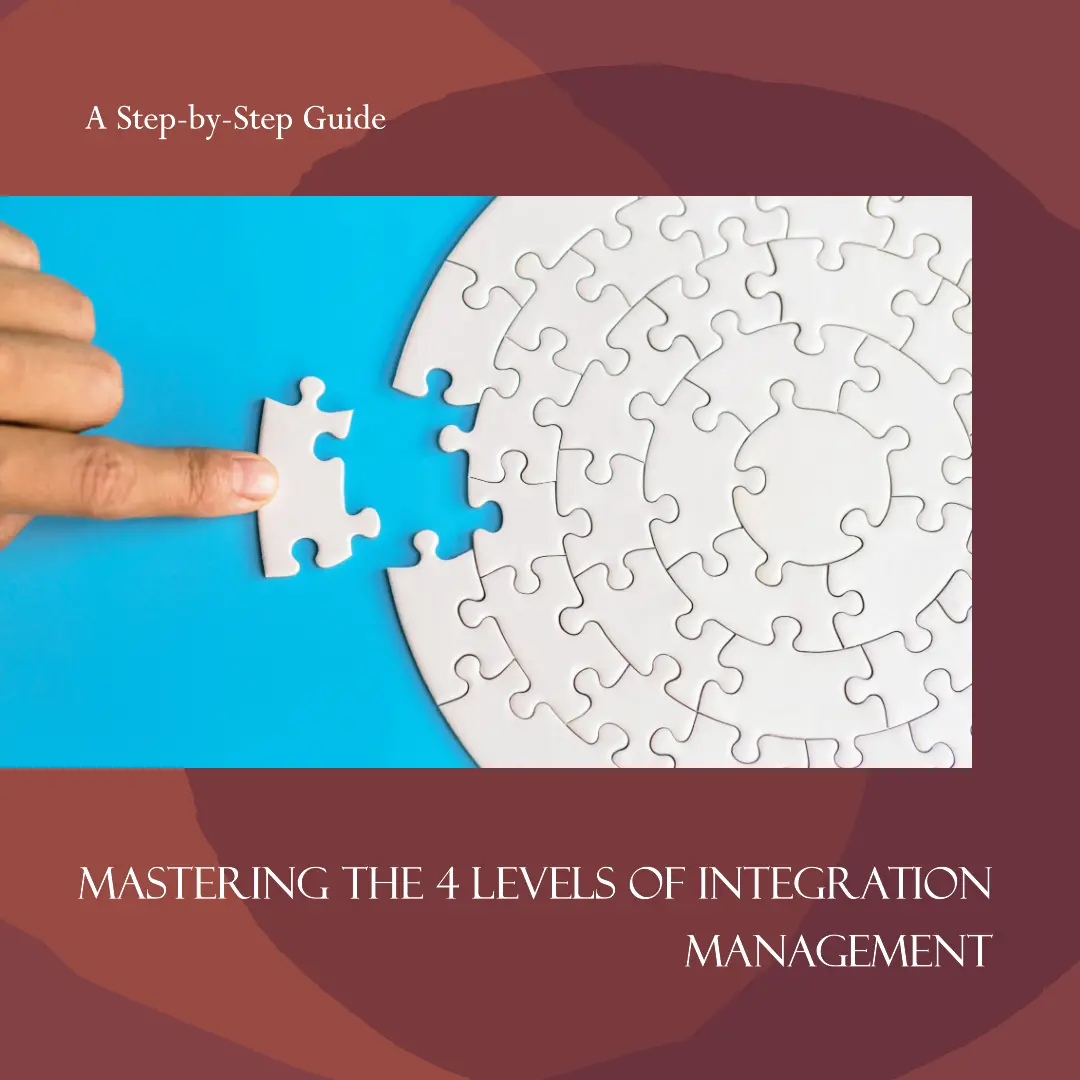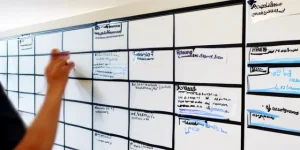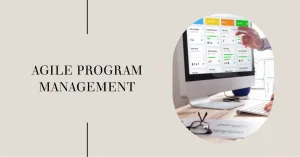I. Introduction
Hey there, fellow project managers and enthusiasts! Today, I want to dive into a topic that’s near and dear to my heart: integration management. If you’ve ever managed a project, you know how crucial it is to keep all the moving parts working together smoothly. That’s where integration management comes in – and mastering it can make all the difference between project success and failure.
In this step-by-step guide, we’ll explore the four levels of integration management and share some practical strategies for mastering each level. Whether you’re a seasoned project manager or just starting in the field, I believe this guide will provide valuable insights and tools to help you navigate the complexities of managing projects effectively.
So, grab your favorite beverage, get comfy, and let’s dive into the fascinating world of integration management together!
II. Level 1: Individual Integration
First things first, let’s talk about the foundation of successful integration management: individual integration. It all begins with you, the project manager, being fully integrated into the project. You need to have a clear understanding of the objectives, expectations, and your role in achieving project success. After all, you can’t lead a team to victory if you’re unsure about the game plan, right?
A. Definition and significance of individual integration
Individual integration refers to the process of aligning your personal goals, skills, and knowledge with the project’s objectives. It’s about being in sync with the project’s requirements and understanding how you can contribute to its success. This level of integration is essential because it sets the stage for effective teamwork and collaboration in the later stages.
B. Steps to achieve individual integration
- Setting clear objectives and expectations: Begin by defining the project goals and understanding what is expected of you as the project manager. Make sure you have a solid grasp of the project scope, deliverables, and key milestones.
- Enhancing communication skills: As a project manager, effective communication is your bread and butter. Work on honing your listening, speaking, and writing skills to better relay information and understand your team members’ concerns.
- Prioritizing tasks and responsibilities: With a clear understanding of the project objectives and your role, prioritize your tasks to stay focused on what matters most. This will help you stay organized and make efficient use of your time.
C. Practical strategies for individual integration
- Time management techniques: Adopt proven time management methods like the Pomodoro Technique, time blocking, or the Eisenhower Matrix to help you stay on top of your tasks and responsibilities.
- Professional development resources: Keep up with industry trends and best practices by attending webinars, conferences, or enrolling in courses. Continuous learning is essential to staying adaptable and effective as a project manager.
- Self-assessment and reflection: Regularly evaluate your performance and identify areas for improvement. Reflect on your successes and setbacks, and use them as learning opportunities to grow as a project manager.
Remember, individual integration is the foundation upon which the other levels are built. Invest time and effort in mastering this level, and you’ll be well on your way to becoming an integration management pro!
III. Level 2: Team Integration
Now that we’ve covered individual integration, let’s move on to the next level: team integration. As project managers, we know that the success of a project largely depends on the effectiveness of the team. So, let’s explore how to create a well-integrated, high-performing team that can conquer any challenge thrown their way.
A. Definition and significance of team integration
Team integration is all about creating a cohesive and collaborative environment where team members work together towards a common goal. It involves fostering trust, open communication, and shared commitment to the project’s success. A well-integrated team can maximize productivity, reduce conflicts, and ultimately deliver better results.
B. Steps to achieve team integration
- Building trust and rapport within the team: Establish a positive and supportive team culture by getting to know your team members on a personal level, showing empathy, and promoting transparency.
- Encouraging open communication and feedback: Create an environment where team members feel comfortable expressing their ideas, concerns, and opinions. Encourage regular feedback sessions and provide constructive criticism to help everyone grow and improve.
- Aligning team members’ goals with project goals: Ensure that each team member understands how their role contributes to the project’s success. This will help them stay motivated and focused on their tasks.
C. Practical strategies for team integration
- Team-building activities and exercises: Organize team-building events like workshops, offsite retreats, or even informal gatherings to help team members bond and build trust. The stronger the relationships, the more effective the teamwork.
- Conflict resolution techniques: Familiarize yourself with conflict resolution strategies, such as active listening, negotiation, and mediation, to address and resolve disputes promptly and effectively.
- Utilizing collaboration tools: Make use of project management and collaboration tools like Trello, Asana, or Slack to streamline communication, track progress, and ensure everyone is on the same page.
By focusing on team integration, you’ll create a powerhouse of talent, dedication, and collaboration that can tackle even the most challenging projects. So, don’t underestimate the power of a well-integrated team – it could be the key to unlocking your project’s full potential!
IV. Level 3: Interdepartmental Integration
Great job on mastering individual and team integration! Now, let’s take it up a notch and talk about interdepartmental integration. In today’s fast-paced and interconnected world, cross-functional collaboration is more important than ever. So, let’s dive into how you can bring departments together to drive your project towards success.
A. Definition and significance of interdepartmental integration
Interdepartmental integration refers to the process of connecting and aligning various departments within an organization to work together towards a shared project goal. It’s about breaking down silos, fostering collaboration, and ensuring that everyone is on the same page. This level of integration is crucial because it helps to optimize resources, streamline decision-making, and ultimately deliver better project outcomes.
B. Steps to achieve interdepartmental integration
- Developing cross-functional relationships: Build strong relationships with key stakeholders from different departments to foster cooperation and mutual understanding.
- Facilitating interdepartmental communication and collaboration: Promote open communication channels and encourage collaboration between departments to ensure that everyone is working in harmony.
- Aligning departmental goals with project goals: Ensure that each department understands how their contributions fit into the bigger picture and how their work aligns with the overall project objectives.
C. Practical strategies for interdepartmental integration
- Cross-departmental meetings and workshops: Organize regular meetings, workshops, or brainstorming sessions that involve representatives from different departments to exchange ideas, align goals, and share progress updates.
- Project management software and tools: Utilize project management tools like Basecamp, Monday.com, or Microsoft Teams to centralize communication, share documents, and track project milestones across departments.
- Establishing a culture of shared goals and accountability: Foster a sense of shared responsibility and accountability by emphasizing the importance of each department’s contribution to the project’s success.
By successfully integrating various departments within your organization, you’ll create a well-oiled machine that can navigate challenges, leverage diverse perspectives, and ultimately deliver outstanding project results. So, embrace interdepartmental integration and watch your projects soar to new heights!
V. Level 4: Organizational Integration
Congratulations! You’ve made it to the final level of integration management: organizational integration. This level focuses on aligning your project with the overall strategy and vision of your organization. When you achieve organizational integration, you’re not just ensuring the success of your project; you’re also driving your entire organization forward. So, let’s explore how to make this happen.
A. Definition and significance of organizational integration
Organizational integration is the process of aligning your project’s goals and processes with the larger organizational strategy. It’s about ensuring that your project contributes to the overall success and growth of your organization. This level of integration is essential because it helps secure the necessary support, resources, and commitment from top-level management.
B. Steps to achieve organizational integration
- Aligning project goals with organizational strategy: Ensure that your project’s objectives are in line with the organization’s long-term vision and strategic goals. This alignment will help your project gain the support and backing it needs from key decision-makers.
- Ensuring organizational support and resources for project success: Engage with top-level management, stakeholders, and other relevant parties to secure the necessary resources, budget, and commitment for your project.
- Continuous improvement and knowledge sharing across the organization: Promote a culture of learning and improvement by sharing project insights, best practices, and lessons learned with the rest of the organization.
C. Practical strategies for organizational integration
- Change management techniques: Familiarize yourself with change management strategies to help your organization adapt and embrace the changes brought about by your project.
- Leadership support and sponsorship: Cultivate strong relationships with organizational leaders to gain their support and sponsorship, which can help secure resources and pave the way for project success.
- Knowledge management systems and best practices: Implement knowledge management systems or adopt best practices to document, store, and share project learnings and insights across the organization.
By mastering organizational integration, you’ll not only elevate the success of your project but also contribute to the growth and progress of your entire organization. So, go forth and champion organizational integration – it’s the final piece of the puzzle in your journey towards integration management mastery!
VI. Conclusion
Wow, what a journey it has been! Together, we’ve explored the four levels of integration management – individual, team, interdepartmental, and organizational – and delved into practical strategies for mastering each level. I hope this step-by-step guide has provided you with valuable insights and tools to help you excel in your project management journey.
As we wrap up, remember that integration management is an ongoing process that requires continuous learning, adaptation, and improvement. Don’t be afraid to revisit these strategies and refine your approach as you take on new projects and face unique challenges.
I would love to hear about your experiences with integration management and any additional strategies that have worked for you. Feel free to share your stories, insights, and tips in the comments below. Let’s continue learning and growing together in our quest for project management excellence!
So, here’s to mastering integration management and achieving project success – one step at a time!
To find out how Artificial Intelligence is changing the Project Management landscape, you have enjoy reading this article https://www.shaunstoltz.com/did-artificial-intelligence-just-change-everything-about-project-management/Find out more about Shaun Stoltz https://www.shaunstoltz.com/about/
This post was written by an AI and reviewed/edited by a human.



